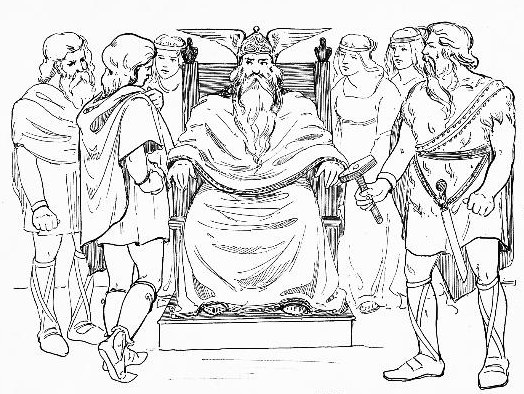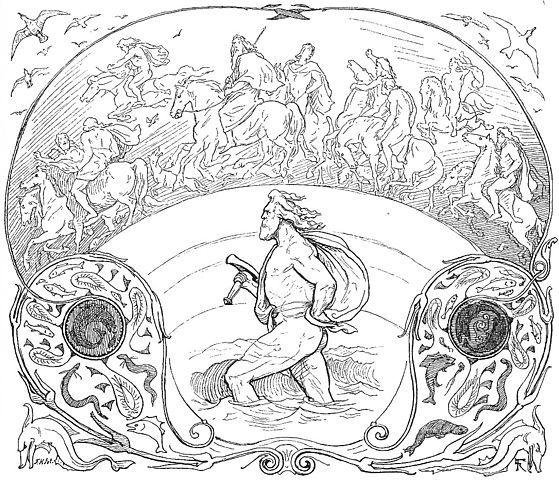Most researchers and experts concur that the earliest stories of Old Norse mythology date back to about 1000 AD. However, images and symbols depicted on runes, rock art, or old Scandinavian gold medals and pendants, known as “bracteates,” go back to the fifth century AD or even earlier.
What Are the Early Sources of Norse Mythology?
Written records like Snorri Sturluson’s Prose Edda, the Poetic Edda, and the Icelandic sagas of the late Middle Ages (around the 13th century) tell us the familiar stories of Odin (or Óðinn), Thor, Loki, and the rest of the Norse gods.
This literature traces the aspects of the old Norse religion the Vikings practiced, established long before Christianity arrived. The credibility of these accounts, written many centuries after the myths and rituals happened, is sometimes questioned.
The ancient gold bracteates can deliver some answers. One discovered in western Sweden depicts Fenrir severing Tyr’s arm with his mighty jaws. Others show when the mistletoe spear kills Baldr as Odin and Loki look on.
Contact with the Romans throughout Northern Europe during the Roman Iron Age (300 to 400 AD) may have introduced the Roman custom of naming days of the week after gods or planets. This influence may show how some days of the week can trace their origin back to Tyr (Tuesday), Frigg (Friday), and Odin (Anglo-Saxon: Woden’s day or Wednesday).
The Basic Facts About Norse Mythology
Contrary to today’s more widespread belief systems, such as Christianity, Islam, or Judaism, Norse religious beliefs were polytheistic, involving several gods and goddesses, not just one.
Búri was the “father of all gods,” but the first members of the true pantheon of the Æsir were his sons Vili and Vé, and above all, Odin. The three sons killed the giant Ymir in Ginnungagap, ending the giants’ rule.
There were originally two pantheons. The first was the Æsir from Asgard, comprising gods such as Odin, Thor, Frigg (originally from Vanaheim), Loki, and Tyr.

The second consisted of the Vanir from Vanaheim. Their gods were Njord, Freyja (or Freya), and Freyr. These gods carried magic weapons like Mjölnir (Thor’s hammer) and used fantastic creatures, such as Sleipnir, Odin’s eight-legged horse.
The Nine Realms and Yggdrasil the World Tree
Their cosmology centered on Yggdrasil, the ash tree, or the Norse world tree. Nine realms sat in its branches and roots, including the human world of Midgard and Niflheim, which contained Hel, the land of the dead.
The religion believed in an afterlife, exemplified by Valhalla and its retrievers of slain warriors, the Valkyries. There was an end of days prophecy called Ragnarök.
“Good” and “Evil”
There was “good” and “evil” in the worlds. The Jötnar from Jötunnheimr were the “bad guys” in many stories. Dwarves also exist; they are insular and mean, although not necessarily malevolent.
Other evil creatures were Fenrir, a monstrous wolf, and Jörmungandr, a huge poisonous serpent.
Where Did Norse Mythology Originate?
Norse myth originated in Scandinavia (Denmark, Norway, and Sweden). It spread to Iceland when Norwegian farmers settled there during the Viking age.
Old Norse religion is a North Germanic offshoot of the primary Germanic group.

Which Countries Believe in Norse Mythology?
Modern Nordic paganism still exists in some European countries and countries with sizeable numbers of European descendants, like the U.S. and Canada.
Ásatrú is a religious belief that resurrects aspects of Viking and Icelandic pre-Christian religion. Iceland recognized the faith in 1973, and with more than 5,000 members, the BBC reported in 2019 that it was one of the fastest-growing religions in that country.
Is Norse Religion Older than Christianity?
Yes.
Christianity is considered to have started with the birth of Jesus Christ in the year zero. However, many scholars think that Christian beliefs actually date back to 6 and 4 BC. Christian historians believe that the Ministry of Jesus around 30 AD is the earliest record of Christianity.
The earliest examples of Norse Paganism are the spoken stories from between the Bronze Age (3,000 to 1000 BC) and the Iron Age (started around 1000 BC).
Which is the Oldest Mythology?
The oldest recorded example of mythology is a Mesopotamian epic poem called The Epic of Gilgamesh, written about 2000 BC. Enuma Elish, an account of the creation of Babylon, was written around 1200 BC.
The earliest Greek text was Theogony by the poet Hesiod, written about 700 BC. To find the first example of written Latin, a four-word inscription on a cloak pin, you must go back to 700 BC.

